"A different kind of good bread is possible …" We have tasted it in Dakar!
At the World Social Forum and the International Fair of Agriculture and Animal Resources (FIARA) in Dakar some very interesting food innovations passed their test with success. Until today it was generally accepted that it is not possible to mix in more than 15% of flour from local grain with wheat flour to make bread.

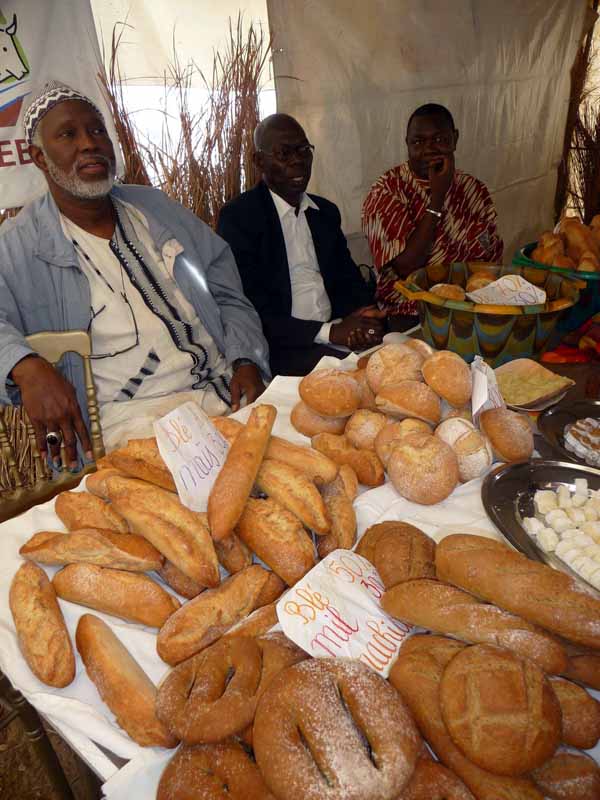 Now however , together with the association « Solidarité » two bakers, Michel and James, have proven that it is quite possible to incorporate large quantities of local cereals. They have managed to do this thanks to a different bread-making technique - based on leaven without added boosters and with only a small quantity of yeast, kneading the dough slowly and allowing it a longer than usual time to rise. It is then baked at a gradually falling temperature. This makes it possible to produce well structured and aired bread, which has a higher nutritional value and keeps longer than the current French baguette made of 100% wheat flour.
Now however , together with the association « Solidarité » two bakers, Michel and James, have proven that it is quite possible to incorporate large quantities of local cereals. They have managed to do this thanks to a different bread-making technique - based on leaven without added boosters and with only a small quantity of yeast, kneading the dough slowly and allowing it a longer than usual time to rise. It is then baked at a gradually falling temperature. This makes it possible to produce well structured and aired bread, which has a higher nutritional value and keeps longer than the current French baguette made of 100% wheat flour.
They started out by adding first 40% millet or maize, then 30% maize and over 10% groundnut flour, then 50% millet or maize and finally dough with 25% millet and 25% manioc. All these breads were found tasty.I myself tried one bread 50% wheat flour and 50% maize. It was excellent.
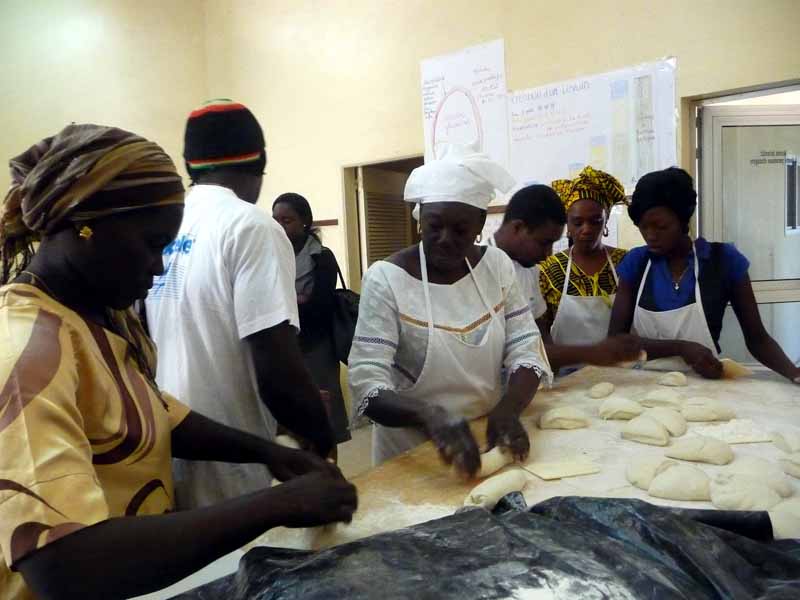
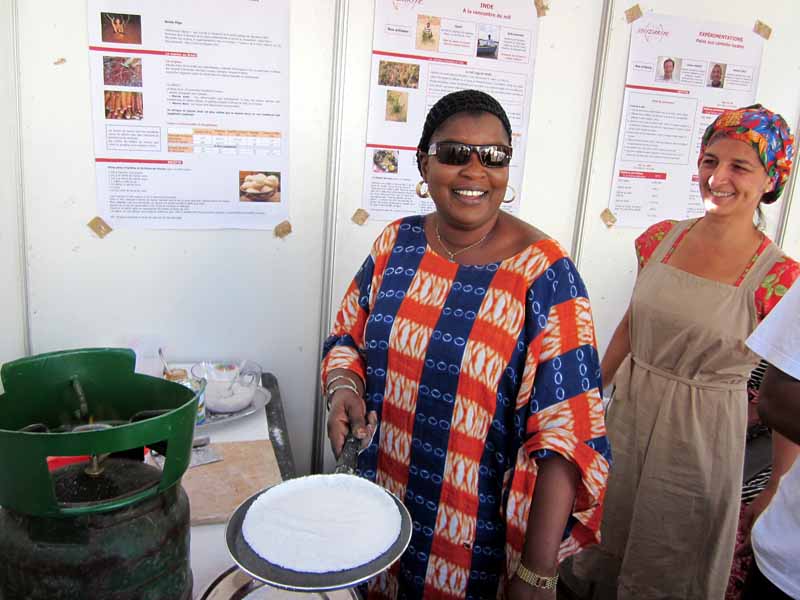 These products were seen with enthusiasm both by the 6 bakers, who had learnt the new techniques (three professionals and three women beginners) and consumers, agricultural officials and even research staff from the Institute of Food Technology in Dakar. The price, 150 CFA francs for a loaf of 220 grams, was another valued aspect. The demand for this bread was greater than the supply and nobody complained about the price. It can be compared to the 175 francs current price for a baguette of 210 grams, made exclusively from wheat flour.
These products were seen with enthusiasm both by the 6 bakers, who had learnt the new techniques (three professionals and three women beginners) and consumers, agricultural officials and even research staff from the Institute of Food Technology in Dakar. The price, 150 CFA francs for a loaf of 220 grams, was another valued aspect. The demand for this bread was greater than the supply and nobody complained about the price. It can be compared to the 175 francs current price for a baguette of 210 grams, made exclusively from wheat flour.
The two bakers also made biscuits of 100% millet or maize. flour and others with a 40% groundnut flour added to wheat flour, which gave a pleasant taste and finally also biscuits with a 40% millet, manioc or maize content.
Maize, millet and manioc tortillas
The baker team also included two Mexican women, Madelen and Maria, who made maize tortillas (shape and size like pancakes) and two Indian women, Ugam and Subramania who made millet chapatis and a Brazilian nutritionist who did manioc tortillas.
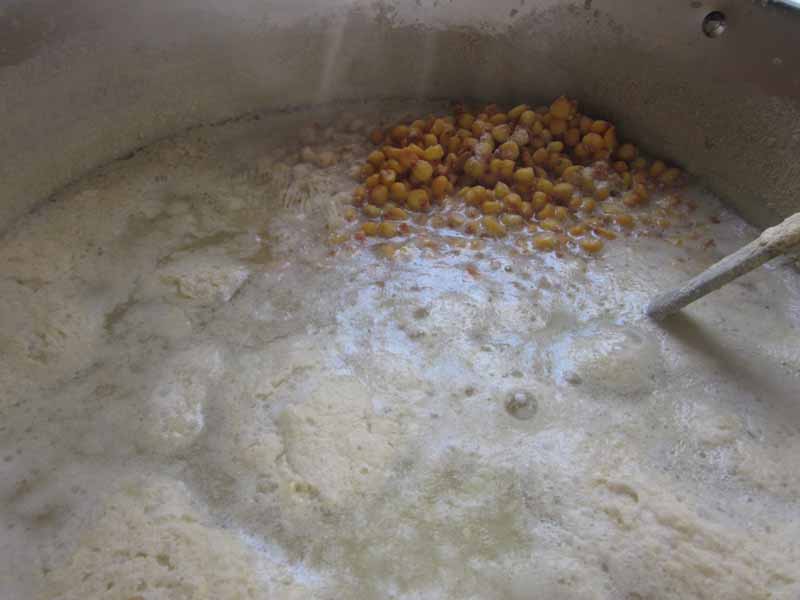
 During the cooking hours at the fair, a large number of visitors - especially women - came to take a close look at the work and were particularly interested in the maize and millet tortillas, asking to enlist for a training course. All the maize and manioc tortillas produced on the spot were immediately eaten and relished by the visitors.
During the cooking hours at the fair, a large number of visitors - especially women - came to take a close look at the work and were particularly interested in the maize and millet tortillas, asking to enlist for a training course. All the maize and manioc tortillas produced on the spot were immediately eaten and relished by the visitors.
Maize/corn grain is first boiled in lime water Hand grinder and press for making maize tortillas For the maize (Mexican) tortillas, Madelen and Maria followed the traditional way: they first boiled the maize in lime water - at the fair on the Tuesday evening and thus they had a good suppy of moist (nixtamalised) maize grains to bake on the Wednesday morning. They ground them in a small manual grinder, similar to a meat chopper, just before starting each new tortilla.. These maize tortillas are served hot, either plain or with a pinch of salt, or jam, or sardines (small sardines fried on charcoal with a splash of oil).
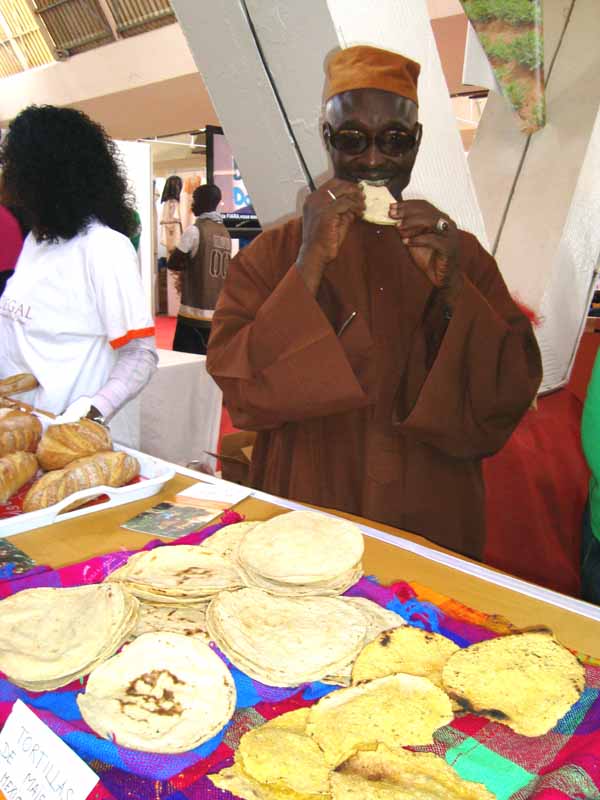
 Tasting samples of maize tortillas Baking maize and millet tortillas This demonstration by the Solidarity team is of considerable interest, not just for Senegal. Burkina Faso should take an interest too, as it continues to produce more maize every year and also continues to import more wheat or wheat flour every year. The baking demonstration should be reiterated and followed up, training of numerous bakers should be provided and campaigns organised "to decolonise our food" …
Tasting samples of maize tortillas Baking maize and millet tortillas This demonstration by the Solidarity team is of considerable interest, not just for Senegal. Burkina Faso should take an interest too, as it continues to produce more maize every year and also continues to import more wheat or wheat flour every year. The baking demonstration should be reiterated and followed up, training of numerous bakers should be provided and campaigns organised "to decolonise our food" …
All those interested in "food justice" ought to show up and prove that their interest in such an experience is real.
Ouagadougou, February 26th 2011
Maurice Oudet
Director, SEDELAN









